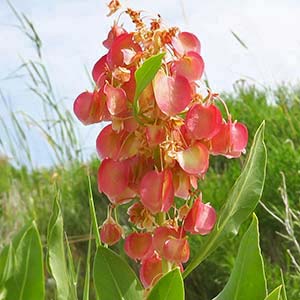Rumex venosus
Rumex longifolius
rumex veine, vein dock, veiny dock, wild-begonia, wing dock
door-yard dock, long-leaf dock, long-leaf or northern or dooryard dock, rumex a feuilles longues, yard dock
ascending or, rarely, erect, usually producing axillary shoots near base, (10–)15–30(–40) cm.
erect, branched distal to middle, 50–120(–160) cm.
blades ovate-elliptic, obovate-elliptic, or ovate-lanceolate, (2–)4–12(–15) × 1–5(–6) cm, subcoriaceous, base narrowly to broadly cuneate, margins entire, flat or slightly undulate, apex acute or acuminate.
ocrea deciduous or partially persistent at maturity;
blade broadly lanceolate to ovate-lanceolate or oblong-lanceolate, normally 25–50(–60) × 7–15 cm, ca. 3–4 times as long as wide, base broadly cuneate, rounded-truncate, or slightly cordate, margins entire, undulate or weakly crisped, occasionally flat, apex acute or subacute.
terminal and axillary, usually occupying distal 2/3 of stem/shoot, usually dense, or interrupted in proximal part, broadly paniculate.
terminal, occupying distal 1/2 of stem, normally dense, narrowly paniculate, branches usually straight or arcuate.
articulated near middle, filiform or slightly thickened, (8–)10–16 mm, articulation distinct, slightly swollen.
articulated in proximal 1/3, filiform, 4–9 mm, articulation distinctly swollen.
5–15 in whorls;
inner tepals distinctly double-reticulately veined, orbiculate or reniform-orbiculate, 13–18(–20) × (20–)23–30 mm, base deeply emarginate or cordate, margins entire, apex rounded, obtuse, rarely subacute, with short, broadly triangular tip;
tubercles absent, occasionally very small.
10–20 in whorls;
inner tepals broadly orbiculate or reniform, (4.5–)5–6(–7) × (4.5–)5–7(–7.5) mm, base usually distinctly cordate, margins entire or subentire to very weakly erose, flat, apex obtuse or, rarely, subacute;
tubercles normally absent,sometimes with 1 indistinct tubercle or slightly thickened midvein less than 1–1.3 mm wide.
brown or dark brown, 5–7 × 4–6 mm.
dark brown or brown, (2.5–)3–3.5(–4) × 1.5–2 mm.
= 40.
= 60.
Rumex venosus
Rumex longifolius
Rumex venosus is a distinctive species rarely confused with any other members of the genus. However, I have seen herbarium specimens of it misidentified as R. hymenosepalus, and vice versa.
(Discussion copyrighted by Flora of North America; reprinted with permission.)
Most records of Rumex longifolius from the Great Plains (Great Plains Flora Association 1977; R. B. Kaul 1986) refer to R. pseudonatronatus (J. E. Dawson 1979), which can be distinguished from R. longifolius by its narrower leaves, smaller and more distinctly triangular inner tepals, and purplish or reddish brown stems at maturity. The two species are closely related; they were placed by K. H. Rechinger (1949) in subsect. Longifolii Rechinger f.
(Discussion copyrighted by Flora of North America; reprinted with permission.)
- Local floras:
CA,
OR,
WA
- Local Web sites:
CalFlora,
CalPhotos,
Flora NW,
KS Wildflowers,
MN Wildflowers,
PNW Herbaria,
Turner Photog.
WildflowerSearch
iNaturalist (observations)
USDA Plants Database
- LBJ Wildflower Center
- SEINet
- Plants of the World Online
- Encyclopedia of Life
- Wikipedia
- Google Image Search


